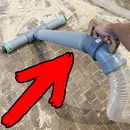Introduction: Nifty Tool Bag
Being a maker is not easy! The constant need for new tools and ways to organise the old ones is a big headache. Especially if you are a one that travels a lot.
With the summer arriving if faced a real problem - how to keep my most essential tools with me at all times. I needed something that could hold all my tools, would be rigid enough and at the same time look classy and original.
I had a vision of a compact little tool bag made out of leather-like material with wooden handles.
To begin with, I have to say that I am not a skilled sewer. I am just a guy who reads some instructions, watches some YouTube videos and experiments a lot. So no need to say that if you feel that you would do something differently than me, do it!
Up to today, my bag has held up really well - no signs of wear or tear! I am also pretty pleased with the design and looks of it, although I would change the dimensions if I could do it again. To be honest the bag is too small for all the different stuff I want to keep in there. Somewhere in the not do distant future, I will make another tool bag. It will be bigger and will have organising pockets.
If you like my work be sure to follow me here on Instructables or on Instagram @kammsuhu
And of course, this project is taking part in a few competitions, soooo........ *wink,wink* ;)
Step 1: Tools and Materials
List of tools and materials for this build is not long, but some things are essential.
I have added some amazon links if you are interested ;)
Total cost of the project for me was around 40-50 euros
Materials
- Leather or leather-like material (or in that case any other strong fabric)
- Wooden dowel big enough to hold comfortably in your hand
- Strong thread
- Contact cement
- Sheet of plywood for the bottom
- Small plastic feet
- Patches for decoration
- Button magnets
- Epoxy glue
Tools
- Sewing machine or/and tons of patience when hand sewing
- Sewing needles
- Measuring tape
- Fabric scissors
- Marker
- Thimble
- Awl
- Small drill bit
- Spade bit (same size as magnets)
- Cordless drill
For the material, I chose synthetic leather because it is thick, strong and is made without causing any pain or suffering to the animals. And it is if course cheaper than real leather.
In the materials picture, you can also see few things I did not use in my build. I planned to also add a belt to easily carry my bag around, but it turned out not to work with my design, so I decided to leave it out. Also on the finished product, I added little plastic feet, which keep the leather from touching the floor.
I am pretty sure that many of you think there has to be a better way to work with leather. You are right! There are special leather working tools and techniques (that I still know nothing about). See the Instructables Leatherworking class or Jessica Ratfinc's Ibles if you want to know more about working with this material.
Let's get started!
Step 2: Preparing the Materials
To start off I made a paper template of the bag. This was just to make sure that it would turn out somewhat the right shape. Also, my cat really loved it!
I took my wooden dowel and cut it to the desired length. Then I eyeballed a straight line and cut it in two (lengthwise). I did some sanding and it was almost done.
After that, I moved on to the fabric. I carefully traced out the dimensions on the inside surface and then cut it out. I also cut two smaller pieces that would later become the ends. I should have made the sides of the main piece higher, as right now not too many tools fit in my bag. The length and the "floor space" of the bag are quite OK.
When this was done I moved back to the handles. I wanted my bag to be so that the handles clip together on their own to avoid dust and woodchips getting in there. To do this I glued in four pairs of strong button magnets. First, I drilled a small hole through one side of the dowel and slightly in the other side too. I did this to mark the magnet centre points on both sides. They have to line up correctly, otherwise, the handle would clip together crooked. Then I drilled holes for the magnets with a spade bit. The only thing left to do was to add epoxy to make it permanent. At first, I thought that four pairs of magnets would be too much, since they are really strong, but in the end, it turned out to be just fine (could have even added a few more)
Step 3: Assembly
I started by cutting a thin strip of leather and gluing and sewing it to the edges near the handles. This was to add strength to it. Then I sewed three lines to the end pieces - the middle one from the outside and two outer ones from the inside. I did this so that when I close the bag, the ends would neatly fold together each time (instead of randomly being pressed together) .
Then it was just the matter of sewing ends to the main section. Once again to add strength, I glued and sewed a thin extra strip to the edges. This time, I could not do it with my sewing machine anymore since the material was getting so thick. I moved to hand sewing. I did "cross stitching" (not sure if it is called that way), where I used two needles. At first, I just pressed the needles trough with a thimble, but at some point, it got so hard that I had to purchase an awl to punch holes. It made it a little bit easier. Still, it was a really time-consuming, painful and hard thing to do. At times like these, one really wishes he had the right leatherworking tools.
Step 4: Handles
Finally, I attached the handles. Once again first with contact cement and then sewing just to be sure they can hold the weight.
Apply the glue to both surfaces and let it dry for five or so minutes. Press together firmly and you are done. Different glues may vary so read the instructions on your glue tube.
Step 5: Finishing Touches
I also decided to decorate my bag with a few patches. Mine were iron-on patches but with only glue these never seem to hold on really long. And the Instructables iron-on patch is really weird. I have never been able to stick it to any surface by ironing it. It does not show a sign of sticking, so I always sew it.
Be careful when ironing synthetic leather as it melts really easily!
The bag on its own would not hold its shape (when carried around) so I added a 12mm plywood to the bottom.The material could be anything (and it does not need to be so thick), but plywood was the only thing I had.
As I mentioned earlier I added small plastic feet similar to these. It turned out to be a really great idea since it keeps the bag off the ground (less wear and won't get wet so easily)
Step 6: The End
Like always I am quite happy how it turned out.
As I said the size is bit small, so if you plan on making one, be sure to take it into account.
If you have any comments or questions let me know in the comments. I would gladly answer them!
If you like my work be sure to follow me here on Instructables or on Instagram @kammsuhu
I hope I have inspired you!
Cheers,
Andu

Runner Up in the
Tandy Leather Contest 2016

Participated in the
Maker Olympics Contest 2016













